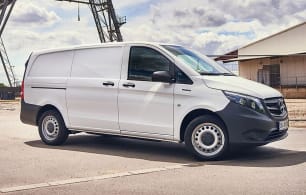The BMW X3 was developed with family buyers in mind and that has paid dividends because it has an extremely practical cabin with lots of thoughtful storage.
Each of the four doors has a bottle holder and generously-sized pocked for extra storage. There are two cup-holders in the centre with a wireless charging pad, secure spot for the key fob and USB port in easy reach. You can slide a roller cover down to hide valuables.
Key driving controls are smartly grouped together around the iX3's unconventional gear selector. Here, you'll find the start/stop button along with hard switches for drive mode selection, stability control and exterior cameras.
Right next door is where the rotary 'iDrive' controller lives with yet more physical shortcut buttons. Including the extra option to easily interact with the multimedia system on the move is a refreshing delight that you don't see in so many touchscreen-heavy EVs. There's also a physical stack for HVAC and seat heating controls.
The 12.3-inch touchscreen is responsive and bright with BMW's slightly older system having a more conventional appearance than the latest software in the iX2. Apple CarPlay and Android Auto are wireless and still work flawlessly.
If there are some negatives, they would be some build-quality niggles. On the whole the materials are high quality and the car is well screwed together but the indicator stalks feel decidedly flimsy compared to BMWs of old and I noticed a rattle from the parcel shelf on the road.
The eight-way power adjust seats with tilt and under-leg extension are classic BMW, being sporty enough to hold you in but with enough padding to stay comfy. Though we will knock this car down for lacking power lumbar adjust.
Those in the back will be plenty comfortable even if they're taller than 180cm with ample head, leg and toe-room. There doesn't appear to be a major compromise to the floor height despite BMW stacking 10 lithium-ion modules beneath.
Vision out is excellent with an expansive glasshouse and full-length sunroof.
Amenities include two USB-C charge points, a third climate zone, fold-out armrest with pop-up cup holders and generous storage in the doors.
Fitting child seats should be pretty simple with doors that open wide, two sets of ISOFIX ports (that you can't lose the covers of) and three prominent top tether anchors in the recline-adjustable backrest.
The boot is large with 510L of space at a minimum that expands to 1560L if you fold the 40/20/40 split backrest flat. There's a sense of solidity in that process, too, with sturdy levers and components.
So sturdy that the retractable luggage cover is quite difficult to remove, especially for shorter owners. Other niceties include a single shopping bag hook, LED lighting and 12-volt socket in the back.
No BMW X3 comes with a spare tyre so that should come as no surprise. The iX3 instead has a tyre repair kit. There is underfloor storage in the iX3, though, which is the perfect place to store both charging cables — Mode 2 and 3 — that are included.

